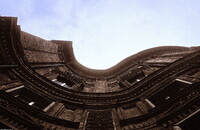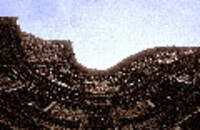| dc.description | North façade, view looking straight up the façade, depicting silhouette where the convex façade meets the concave; Guarini's most renowned achievement in secular architecture is the Palazzo Carignano in Turin. His patron was the deaf-mute Prince Emanuele Filiberto Amedeo of Savoy-Carignano (1628-1709). In 1679 Guarini was commissioned to build on a site outside the medieval walls of Turin. The palace was originally designed to have four wings around a large courtyard, but it was completed in 1683 as an open three-winged composition; decorating and finishing continued well into the 18th century. Four stages in the planning of the Palazzo Carignano exist in draft form (Turin, Archv Stato) and have often been published. The final scheme, which was the one built, shows a layout with a central block facing a piazza and set between two straight side wings running back. The facade of the central block is formed with two sinuous S-curves. In the middle is a tall, oval cylinder, which is joined by sweeping counter-curves to the rectilinear end bays of the wings. Two great staircases wind around the central oval pavilion like arms. They connect to a hexagonal salon on the piano nobile, which in turn leads to the oval grand salone, with a magnificent balcony over the main entrance. This design gives the impression of dramatic conflict between the architectural masses: the central block, wedged between the two side blocks, seems to undulate in slow motion. The uniformity of the brick façade is interrupted by the central portal and the grand balcony above, which are both made from brilliant white stone and seem to burst from the centre impelled by a force exerted from the core of the building at the point of greatest tension. This type of curved inflection was an innovation in Italian Baroque palace design, although Bernini had featured an oval pavilion connected to side bays in his first project for the east front of the Louvre (1664), which Guarini may have seen during his time in Paris. Source: Grove Art Online; http://www.groveart.com/ (accessed 2/3/2008) | en_US |



